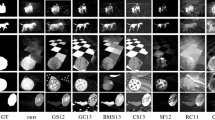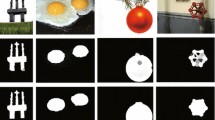Abstract
Object-level saliency detection is significant in many computer vision tasks. In this paper, we propose a novel saliency detection model based on color contrast and image boundaries. The saliency of an image is defined as the contrast between the image elements (regions) and image boundaries elements (regions). We consider the saliency in two-stage procedure rather than in one stage. First of all, according to the definition of saliency, we take four boundaries of image into consideration respectively to obtain a combination coarse saliency map. Furthermore, a new energy function based on the coarse saliency map is proposed, which takes the coarse saliency map as input to yield the final full resolution saliency map. Experimental results on two public datasets demonstrate that the proposed model performs better than the state-of-the-art methods.













Similar content being viewed by others
References
Yarbus, A.: Eye movements and vision. Plenum Press, New York (1967)
Neisser, U.: Cognitive psychology. Appleton-Century-Crofts (1967)
Itti, L., Koch, C., Niebur, E.: A model of saliency-based visual attention for rapid scene analysis. IEEE Trans. Pattern Anal. Mach. Intell. 20(11), 1254–1259 (1998)
Tsotsos, J.: What roles can attention play in recognition? In: Proceedings of seventh IEEE international conference development and learning, pp. 55–60 (2008)
Privitera, C.M., Stark, L.W.: Algorithms for defining visual regionsof-interest: comparison with eye fixations. IEEE Trans. Pattern Anal. Mach. Intell. 22(9), 970–982 (2000)
Siagian, C., Itti, L.: Rapid biologically-inspired scene classification using features shared with visual attention. IEEE Trans. Pattern Anal. Mach. Intell. 29(2), 300–312 (2007)
Gao, D., Han, S., Vasconcelos, N.: Discriminant saliency, the detection of suspicious coincidences, and applications to visual recognition. IEEE Trans. Pattern Anal. Mach. Intell. 31(6), 989–1005 (2009)
Guo, C., Zhang, L.: A novel multiresolution spatiotemporal saliency detection model and its applications in image and video compression. IEEE Trans. Image Process. 19(1), 185–198 (2010)
Itti, L.: Automatic foveation for video compression using a neurobiological model of visual attention. IEEE Trans. Image Process. 13(10), 1304–1318 (2004)
Achanta, R., Estrada, F., Wils, P., et al.: Salient region detection and segmentation. In ICVS (2008)
Achanta, R., Hemami, S., Estrada, F., et al.: Frequency-tuned salient region detection. In CVPR (2009)
Bruce, N., Tsotsos, J.: Saliency based on information maximization. In NIPS (2005)
Cheng, M.M., Zhang, G.X., Mitra, N.J., et al.: Global contrast based salient region detection. In CVPR (2011)
Goferman, S., Zelnik-Manor, L., Tal, A.: Context-aware saliency detection, In CVPR (2010)
Gopalakrishnan, V., Hu, Y., Rajan, D.: Random walks on graphs for salient object detection in images. IEEE TIP (2010)
Harel, J., Koch, C., Perona, P.: Graph-based visual saliency. In NIPS (2006)
Hou, X., Zhang, L.: Saliency detection: a spectral residual approach. In CVPR (2007)
Lu, Y., Zhang, W., Lu, H., et al.: Salient object detection using concavity context. In ICCV (2011)
Wang, L., Xue, J., Zheng, N., et al.: Automatic salient object extraction with contextual cue. In ICCV (2011)
Ma, Y., Zhang, H.: Contrast-based image attention analysis by using fuzzy growing. ACM Multimedia (2003)
Perazzi, F., Krahenbuhl, P., Pritch, Y., et al.: Saliency filters: contrast based filtering for salient region detection. In CVPR (2012)
Wang, W., Wang, Y., Huang, Q., et al.: Measuring visual saliency by site entropy rate. In CVPR (2010)
Zhai, Y., Shah, M.: Visual attention detection in video sequences using spatiotemporal cues. ACM Multimedia (2006)
Liu, T., Yuan, Z., Sun, J., et al.: Learning to detect a salient object. IEEE PAMI (2011)
Yang, J., Yang, M.: Top-down visual saliency via joint crf and dictionary learning. In CVPR (2012)
Li, J., Levine, M.D., An, X., et al.: Visual saliency based on scale-space analysis in the frequency domain. IEEE Trans. Pattern Anal. Mach. Intell. 35(4), 996–1010 (2013)
Xie, Y.L., Lu, H.C., Yang, M.H.: Bayesian saliency via low and mid level cues. IEEE TIP 1, 6 (2013)
Wei, Y.C., Wen, F., Zhu, W.J., et al.: Geodesic saliency using background priors. In ECCV 2, 6 (2012)
Achanta, R., Smith, K., Lucchi, A., et al.: Slic super-pixels. Technical report, EPFL, Tech. Rep. 149300 (2010)
Levin, A., Lischinski, D., Weiss, Y.: A closed-form solution to natural image matting. IEEE Trans. Pattern Anal. Mach. Intell. 30(2), 228–242 (2008)
Tatler, B.: The central fixation bias in scene viewing: selecting an optimal viewing position ndependently of motor biases and image feature distributions. J. Vis. 7(14), 1–17 (2007)
Alpert, S., Galun, M., Basri, R., Brandt, A.: Image segmentation by probabilistic bottom-up aggregation and cueintegration, In CVPR (2007)
Jiang, H., Wang, J., Yuan, Z., et al.: Automatic salient object segmentation based on context and shapeprior. In BMVC (2011)
Li, J., Tian, Y., Duan, L., et al.: Estimating Visual saliency through single image optimization. IEEE Signal Process. Lett. 20 (2013)
Acknowledgments
This work was supported by the Key Project of Hunan Province Science and Technology Planning Project, China (2014G2012).
Author information
Authors and Affiliations
Corresponding author
Rights and permissions
About this article
Cite this article
Xu, M., Zhang, H. Saliency detection with color contrast based on boundary information and neighbors. Vis Comput 31, 355–364 (2015). https://doi.org/10.1007/s00371-014-0930-9
Published:
Issue Date:
DOI: https://doi.org/10.1007/s00371-014-0930-9




